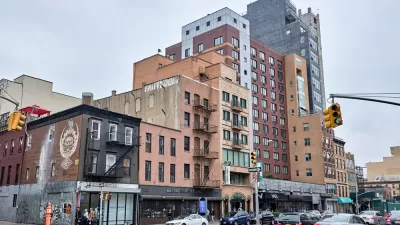Zoning can only be so effective in holding off market forces, according to this column. New York City seems to have finally learned this lesson in the Garment District, but will it inform decisions in other parts of the city?

Crain's New York Business columnist Greg David writes that New York City has fixed its "worst land-use mistake."
The decision in question dates to 1984, when political forces concerned about the potential for rising rents to drive businesses away resulted in manufacturing only zoning for side streets n the Garment District. "Apparel jobs vanished anyway—some 12,000 remain in the city and fewer than 5,000 in the Garment Center—in a telling example of how land-use policy is helpless in the face of economic forces," according to David.
"After almost two decades of trying, the city will finally end the restrictive zoning this fall," reports David.
According to David, the zoning changes reflect a city, and a planning regime, that has faced reality when it comes to manufacturing jobs, and the amount of space reserved for manufacturing uses around the city.
"In recent years, architects and design firms have swept in, along with tech companies and nonprofits—some in space restricted to manufacturers—bringing in a new, affluent workforce," writes David. "Even more transformational, the district is now home to 42 hotels, with 12 more under construction. Tourists have in turn lured restaurants and bars."
FULL STORY: Finally, a fix for the city's worst land-use mistake

Planetizen Federal Action Tracker
A weekly monitor of how Trump’s orders and actions are impacting planners and planning in America.

San Francisco's School District Spent $105M To Build Affordable Housing for Teachers — And That's Just the Beginning
SFUSD joins a growing list of school districts using their land holdings to address housing affordability challenges faced by their own employees.

The Tiny, Adorable $7,000 Car Turning Japan Onto EVs
The single seat Mibot charges from a regular plug as quickly as an iPad, and is about half the price of an average EV.

Toronto Condo Sales Drop 75%
In two of Canada’s most expensive cities, more condos were built than ever — and sales are plummeting.

Vehicle-related Deaths Drop 29% in Richmond, VA
The seventh year of the city's Vision Zero strategy also cut the number of people killed in alcohol-related crashes by half.

Seattle's Plan for Adopting Driverless Cars
Equity, safety, accessibility and affordability are front of mind as the city prepares for robotaxis and other autonomous vehicles.
Urban Design for Planners 1: Software Tools
This six-course series explores essential urban design concepts using open source software and equips planners with the tools they need to participate fully in the urban design process.
Planning for Universal Design
Learn the tools for implementing Universal Design in planning regulations.
Smith Gee Studio
City of Charlotte
City of Camden Redevelopment Agency
City of Astoria
Transportation Research & Education Center (TREC) at Portland State University
US High Speed Rail Association
City of Camden Redevelopment Agency
Municipality of Princeton (NJ)





























